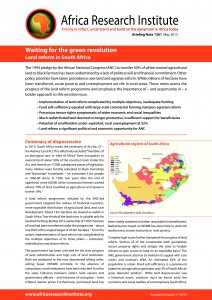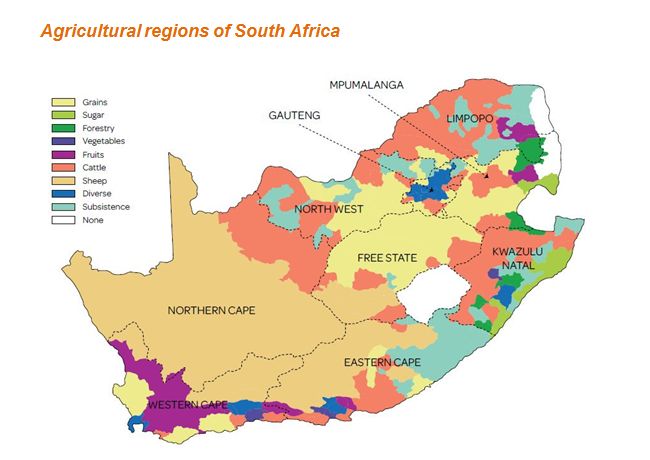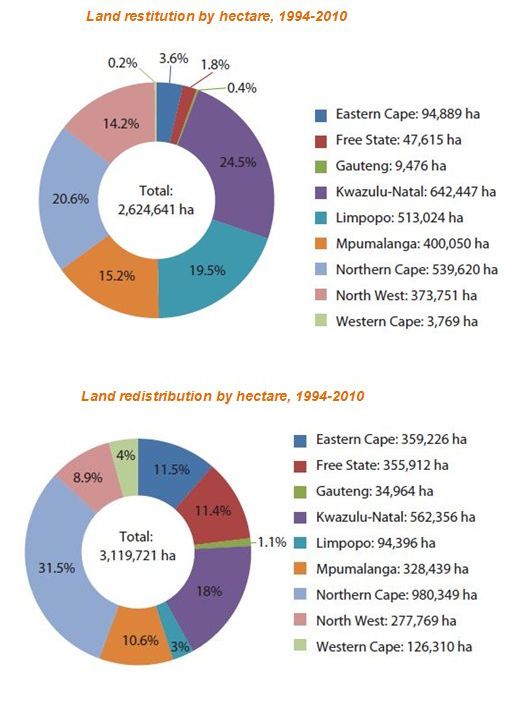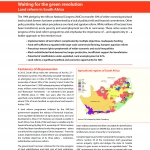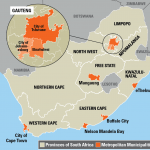The 1994 pledge by the African National Congress (ANC) to transfer 30% of white-owned agricultural land to black farmers has been undermined by a lack of political will and financial commitment. Other policy priorities have taken precedence over land and agrarian reform. While millions of hectares have been transferred, acute poverty and unemployment are rife in rural areas. These notes assess the progress of the land reform programme and emphasise the importance of – and opportunity in – a bolder approach to this emotive issue.
Centenary of dispossession
In 2013, South Africa marked the centenary of Act No. 27 – the Natives’ Land Act. This effectively excluded “members of an aboriginal race or tribe of Africa” from occupation or ownership of about 90% of the country’s land. Under the Act, and more than 17,000 subsequent pieces of legislation, many millions were forcibly relocated to black townships and “Bantustan” homelands – an estimated 3.5m people in 1960-80 alone. In 1996, two years after the end of apartheid, some 60,000 white commercial farmers owned almost 70% of land classified as agricultural and leased a further 19% (1).
A land reform programme initiated by the ANC-led government targeted the redress of historical injustices, more equitable distribution of agricultural land, and rural development. About 13m hectares are classed as arable in South Africa. Two-thirds of the land mass is suitable only for livestock farming. By May 2012, ownership of 7.95m hectares of land had been transferred under the programme – about one third of the original target of 24.6m hectares (2). From the outset, implementation of land reform was complicated by the multiple objectives of its three pillars – restitution, redistribution and tenure reform.
The government has been criticised for the slow progress of land redistribution and high cost of land restitution. Both are attributed to the now abandoned willing seller, willing buyer (WSWB) principle. In the absence of compulsion, most landowners have been reluctant to sell to the state. Collusion between sellers, land valuers and government officials – and instances of corruption – have inflated market prices. Furthermore, purchased land has been widely scattered and often unsuitable for beneficiaries.
Redistribution based on WSWB has done little to diminish landlessness, tenure insecurity or rural poverty. Complex legal issues further hampered the progress of land reform. Section 25 of the constitution both guarantees secure property rights and obliges the state to “enable citizens to gain access to land on an equitable basis”. The ANC government also has to maintain its appeal with core voters and investors alike. An estimated 62% of the population is urban. Food self-sufficiency is a paramount objective, yet agriculture generates only 3% of South Africa’s gross domestic product. While land dispossession was a historical event, solutions must be found amid the economic and social realities of contemporary South Africa.
Land reform featured prominently in the negotiations that brought an end to apartheid and endures in ANC rhetoric. In 2013, the original 1999 deadline for the redistribution of 30% of agricultural land to black South Africans was again postponed – from 2014 to 2025. In no year has more than 1% of the national budget been earmarked for purchasing land (3). According to the Department of Rural Development and Land Reform (RDLR), an estimated R29.7 billion (US$3.2 billion) was spent on the land reform programme between 1994 and 2013.4 This may far exceed the sum originally envisaged by the World Bank but it is equivalent to only a single year’s government budget for housing development. The land issue has been described as “broadly only an agenda item” (5).
Restitution, tenure reform…
The 1994 Restitution of Land Rights Act initiated the process of compensating those deprived of property as a result of racist legislation after 1913. By 2013, 77,148 claims had been settled nationwide. In response to appeals from claimants who missed the December 1998 deadline, new claims will be considered. The programme may also be extended to include pre-1913 dispossessions from, among others, the Khoi and San communities in Northern Cape province.
More than 80% of restitution claims settled by 2006 related to urban land. A vast majority of beneficiaries – 92% – opted to receive financial compensation at a cost of R6 billion (US$652m). To satisfy successful claimants demanding the return of land, 1.44m hectares were acquired for an estimated R10.8 billion (US$1.2 billion).6 Given the need to reclaim specific areas of historical and cultural significance, the state’s bargaining power was limited. “The numbers clearly show who has benefited from the [land restitution] programme observed RDLR Minister Gugile Nkwinti (7).
“The programme of reversing land dispossession must be undertaken in a manner that corrects the injustice while also promoting agricultural stability and food security” – Jacob Zuma, President of South Africa
Legislation designed to improve rights of tenure has been ineffective. For most rural South Africans, security of tenure remains precarious. In 1994-2004, an estimated 942,303 people were forcibly removed from commercial farms – one quarter more than in the final decade of apartheid.8 The 1996 Land Reform (Labour Tenants) Act and the 1997 Extension of Security of Tenure Act (ESTA), which were drafted to strengthen the rights of farm workers and others residing on private land, have been poorly enforced by the police and courts. The creation of “agrivillages” for farm dwellers, proposed by a new Land Tenure Security Bill, is redolent of apartheid legislation.
The 2004 Communal Land Rights Act (CLaRA) aimed to transfer the legal power for determining – or altering – myriad land tenure arrangements in communal areas from the state to traditional authorities. If implemented, the legislation would have affected about 21 million people (9). CLaRA attracted widespread criticism for entrenching pre-1994 homeland boundaries and vesting power in unelected local authorities. In May 2010, CLaRA was declared unconstitutional. The 2011 Green Paper on Land Reform stated that land rights in communal areas would be clarified – but no time frame was given.
… and redistribution
By 2013, 4.12m hectares had been redistributed from white ownership to 230,886 black farmers and entrepreneurs at a cost of R12.9 billion (US$1.4 billion).10 Since 1994, the means by which land was redistributed have evolved from Settlement/Land Acquisition Grants (SLAG, 1995-2000) to the Land Redistribution for Agricultural Development Programme (LRAD, 2001-10). In 2006, the government adopted the Pro-active Land Acquisition Strategy (PLAS), which leases high-potential land to chosen beneficiaries with the option of future purchase. Since the early 2000s, the distribution of grants and land allocations has attested to a clear governmental preference for preserving large-scale commercial farming.
The structure of grants and an insistence on maintaining the original boundaries of transferred farms have fostered Communal Property Associations (CPAs). The necessity to pool financial resources has also spawned “rent-a-crowd” CPAs, with members who have no intention of participating actively in farming. Conflicts within CPAs over how land should be used have contributed to the collapse of numerous projects. In practice, few beneficiaries farm collectively.
Assisted purchases of entire farms by individuals or families are rare. Such applications require proof of substantial capital. In areas of highly mechanised commercial agriculture, partnerships with private investors – based on shared equity or outgrower schemes – are promoted as a way of incorporating black South Africans. Such alliances have been depicted as unequal – an opportunity for white farmers and corporations to spread the risk of capital-intensive farming and gain political credibility (11).
In 2010, 90% of redistributed land was deemed “no longer productive” by the government.12 Success or failure tends to be assessed by comparison to the former function of the land. Very few new landowners possess the working capital, skills and machinery to sustain a large commercial farm – or even part of one. Inadequate support and extension services and the imposition of inappropriate business plans compromise government objectives. The state has paid insufficient attention to the diverse profiles and needs of beneficiaries. Despite the many hindrances, a study of new farmers on redistributed land pre-2006 showed that more than half were earning income from agriculture (13).
Alterations to land reform proposed in the long-awaited 2011 Green Paper included a new four-tier structure of land tenure. The response to the Green Paper was muted. Its 11 pages failed to outline practical measures to address existing problems. The government hopes that a draft expropriation bill, and the introduction of land ceilings and a valuergeneral, will speed up land transfers and prevent inflation of land prices. Critics predict more red tape, lengthy legal challenges from landowners – and the alienation of commercial farmers. The state itself cannot provide much extra land. In 2013, completion of a land audit established that 78% of South African land is private and 22% state-owned. The RDLR blamed the inability to provide further, much-needed detail on an “institutional challenge” (14).
Big farms, small farms, more jobs
Rural development was a principal objective of the land reform programme articulated in the 1994 White Paper on Reconstruction and Development. Significant support for diversified smallholder agriculture was envisaged. Making more land available to smallholders is only one component of a broader policy required to diversify and strengthen South African agriculture.
Despite frequent claims to support smallholders, the emphasis of government has been on trying to graft new owners of redistributed land to existing commercial units. Successive administrations have equated national food security with large-scale commercial farming. Concerns about triggering higher or more volatile food prices by undermining the agricultural status quo loom large among policymakers – and are amplified by commercial farmers’ associations. This fixation does little to alleviate rural poverty.
A vibrant smallholder sector would bolster food security at national and household levels – and improve rural livelihoods. South Africa may be food self-sufficient and a net exporter of comestibles, but an estimated 39% of households live on less than US$45 a month and the poor spend at least 40% of their income on food. Food security is attained by growing enough to meet the needs of the family – or by generating adequate income with which to buy food. Farmers are failing for lack of technical support, irrigation, credit, infrastructure and access to markets – not because of the size of their landholdings.
The productive potential of some four million black farmers, most within the former homelands, remains underexploited. Since 2010, the government has invested R1.8bn (US$196m) to assist new famers improve productivity. The Comprehensive Rural Development Programme (CRDP) aims to roll out 160 sites by 2014. While such commitments are laudable, they are insufficient. In contrast to the requirement of the Comprehensive African Agriculture Development Plan for countries to spend at least 10% of their budgets on agriculture, South Africa allocates just 2% to the sector – among the lowest on the continent.
“The land question must be resolved, if needs be the hard way” – Julius Malema, former president of ANC Youth League, quoting Oliver Thambo
At present, rural job creation – to supplement or provide alternatives to inadequate farm incomes – is equally deficient. The 2011 National Development Plan targets the creation of almost one million agriculture-related jobs by 2030. Between September 2006 and September 2012, the number of South Africans employed in agriculture fell from 1.09 million to 661,000.15 At 52%, the rural unemployment rate is twice the national average.
Responsibility for realising the potential of existing smallholders and beneficiaries of land reform lies with commercial farmers as well as the government. The expansion of mentoring and other initiatives to improve local relationships are essential. But large-scale commercial farms are no “golden goose”. As subsidies were removed and input costs rose, profitability diminished. The number of commercial farmers has declined from about 60,000 in 1994 to under 40,000 – half of whom generate annual turnover of less than R300,000 (US$32,000). The future of South African agriculture will depend on both the preservation of profitable commercial farming and an effective transformation of the smallholder sector.
Politics and populism
Many judgements regarding the success or failure of land reform focus on the number of hectares transferred. This obscures the crucial point that the purpose of land reform was the redress of historical injustice, redistribution of wealth and transformation of rural livelihoods. All of these need more ingredients to succeed than shuffled hectares.
Against the backdrop of subdued economic growth and widespread industrial unrest in 2012, a wholesale restructuring of the agricultural economy is required. This could reasonably be expected to take more than a generation to achieve. The transfer of 7.95m hectares is itself, arguably, no insignificant feat. But more money, greater political will and more skilful implementation are required to counter allegations that land and agrarian reform are merely agenda items.
Competing policy priorities have taken precedence over land reform – and agriculture – since 1994. The achievements of the ANC government are many and significant. The economy remains the largest in Africa. Social grants are received by more than 15m people and will rise to R120 billion (US$13 billion) annually by 2015. Four million new houses have been constructed. A massive infrastructure programme is under way. By contrast, the allocation of 2% of the national budget to agriculture, rural development and land reform for 2013-14 is a paltry sum.
Despite impassioned rhetoric to the contrary, the timidity with which successive ANC administrations have addressed rural development is striking. This lack of political will has multiple justifications. The contribution of agriculture to GDP is small. Concerns of rural voters in a country with an urbanisation level of 62% are of secondary political importance. The ANC’s substantial parliamentary majority gives it a mandate for bolder action in the agriculture sector, which could bolster rural support for the party. Agriculture is a prime source of income for as many as five million people and their dependants. Their votes cannot be taken for granted.
The undertaking to create a million agriculture-related jobs by 2030 might suggest that the ANC recognises the opportunity in agriculture. In the absence of greater financial commitment and political resolve, meandering land and agrarian reform will become increasingly susceptible to political opportunism. Under the leadership of Julius Malema, the ANC’s Youth League made expropriation of white-owned land without compensation one of its main rallying calls. The pre-emption of populist successors to Malema – from whatever quarter – is imperative for rural economic development, stability and social cohesion in South Africa.







